Car Audio Speakers Overview
Loudspeaker Function
The purpose of a loudspeaker (also known as a driver) is to convert the audio signal in its electrical form (from the amplifier) to a pressure wave that we perceive as sound. The sound starts out as a low level signal in the head unit and is transmitted to the amplifier by RCA cables. The amplifier then amplifies (makes greater) the level of the signal and passes it to the speaker through speaker wire. The speaker then converts this electrical energy into mechanical energy and we hear the result as sound. See the diagram below.
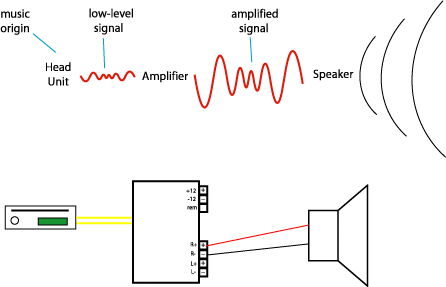 |
| The Reproduction of Sound |
Like any component in a car stereo system the ultimate goal of the speaker is to do its job without adding any coloration (changing of the original sound) to the audio signal. Ideally only one loudspeaker per side would be needed to reproduce the entire audio spectrum. Unfortunately a speaker that can produce low frequencies has too much mass to be able to produce the higher frequencies. This is why we have coaxial and component speakers. Subwoofers are also used in order to produce the extreme lows of music with impact that can be felt as well as heard. Speakers have an extreme range in quality and price. They also have the greatest impact on the overall sound of a car stereo system.
When shopping for car speakers be sure and listen to the speakers before you buy them. There is no other way to know how the speakers will sound to you. Be sure to bring music that you normally listen to when you audition the loudspeakers. This will give you a better idea of how the speakers are reproducing sounds you are familiar with. Listen closely for low level details and how natural different instruments sound. When you have narrowed down your choices to a couple of different speakers, audition them at length. A poor quality car speaker will become tiresome to listen to, usually because of an exaggerated low and high end. Be sure to adjust the bass and treble as well as the volume to levels that are comfortable to you. Beware of salespeople that do an A/B comparison of loudspeakers for you. When switching between speakers, unscrupulous salespeople will turn up the volume slightly on the more expensive speakers to persuade you to buy them. It is an established fact that people tend to prefer the loudspeakers that they determine to be louder.
When choosing loudspeakers, be realistic. If you don't want to modify your existing speaker holes, shop for speakers that will fit in the current space available. Keep in mind depth considerations, especially in doors where speakers may interfere with windows rolling down, dashes where speakers may be limited by ducts for heat and air, and rear decks where depth is limited by torsion bars that run underneath the rear deck. When shopping for subwoofers don't get crazy trying to stuff your car with subwoofers. Consider how much room you have and how much of it you are willing to sacrifice to achieve the low end. This will determine size as well as enclosure type for the woofers you choose. This is all part of system planning.
Power Handling
All speakers will have a power handling specification. Usually two specifications, RMS or continuous power handling and peak or maximum power handling. As in amplifier ratings you can ignore the peak or maximum specification and concentrate on the continuous rating. Let's say a speaker has a rating of 150 watts RMS. This does not mean you have "150 watt speakers" or that your speakers "put out 150 watts". It means your speakers can handle 150 watts of power without being damaged (assuming clean power, see next paragraph). Does this mean you need a 150 watt amplifier? No, you will still choose the amplifier based on your listening tastes and your budget. It simply means you should not use an amplifier that is significantly greater than 150 watts to power this speaker.
When choosing an amplifier for your speakers it's actually better to have a little too much power than not enough. A speaker with plenty of power will be able to play louder and cleaner than a speaker driven by an undersized amplifier. Much of this depends on your listening habits. If you like loud music and find yourself turning the volume up to the maximum then you are probably going to be driving your speakers with "dirty power". This is when you push an amplifier past its limits and drive the speaker output into clipping. Clipping is the term given when a normal music wave is cut short because the amplifier runs out of power. This is the biggest killer of speakers, not overpowering. See the image for an example of a clipped waveform.
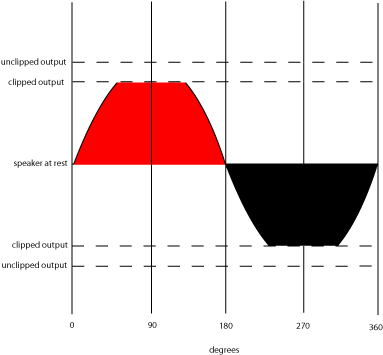 |
| Clipped Waveform from an Overdriven Amplifier |
To give an example of acceptable power you can estimate that a speaker could receive 25% more power than its RMS rating and still have a long life. So a speaker that is rated for 100 watts RMS could safely handle 125 watts RMS. Of course if you push the 125 watt amplifier to its limits you're back in the same boat and your speakers will eventually die a hard death. Be kind to your speakers and to your ears. If your ears or the music sounds bad then turn it down. Your speakers and your ears are being damaged and your speakers are the only one that can be replaced. Use common sense.
Coaxial Speakers
| The least expensive and most common type of car speaker is the coaxial. The coaxial consists of a midrange/woofer with a tweeter placed over the cone, either on a bridge or on a pole that extends from the middle of the cone. These speakers are made in sizes that will exactly fit most brands of vehicles. Advantages of this design include low cost, ease of installation, and a speaker that more closely approaches the one loudspeaker ideal, also called a point source. This is where all frequencies appear to originate from the same location. The disadvantage of this design is a generally lower sound quality for the majority of coaxials available versus the majority of matched component sets available. | 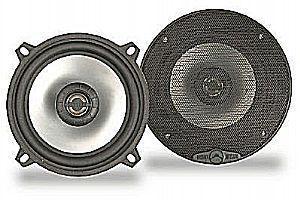 |
| Coaxial Speakers Image courtesy of Bazooka |
Aspects and features that need to be considered when purchasing coaxials are:
Frequency Response: This is the how much of the audible spectrum a loudspeaker can reproduce. The value should be given with a rating of +/- some number of decibels, usually three. The greater the frequency range, the better up to 20kHz and down to 20Hz. Realistically a coaxial speaker will not play much below 80Hz. That's why we have subwoofers.
Mounting Depth: This is the distance that a speaker needs behind its mounting surface for its basket and magnet structure. This can be very important when speakers are being installed in the rear deck of automobile that has torsion bars in the trunk or door speakers with window clearance problems.
Power Handling: This is the amount of power a speaker can withstand before failing after a given amount of time. The most important number is the speakers continuous or RMS (root mean square) power handling. Peak power handling means virtually nothing.
Sensitivity: This is a reference measure of how loud a speaker will be with a certain amount of power at a certain distance. The standard is one watt at one meter. By halving the distance an increase of six decibels will be realized and doubling the power will increase the output by three decibels. This is a trick used by some companies to make their speakers appear more efficient than they are. Most loudspeakers will be in the ninety decibel range. Keep in mind that a difference of three decibels is equivalent to a doubling of the amplifier power.
Tweeter Protrusion: The height that a tweeter sticks above its mounting surface. This will need to be considered when coaxials are being mounted in factory locations under factory grills.
Component Speakers
A component loudspeaker is a single driver designed to reproduce frequencies in a given range. Component speakers are used in tandem with other component speakers to reproduce the entire audio spectrum. As few as two and as many as four or more different size drivers can be used to create a component set. The drivers are kept operating within their designed audio band (frequency range) by a series of frequency filters known as a crossover. By using a crossover to keep speakers operating within a certain range the speakers do not become distorted trying to reproduce frequencies that they are physically unable to reproduce.
 |
| Component Speakers Image courtesy of Kicker |
In order to keep the point source attribute with a set of component speakers these speakers must be placed very near each other. However this is not always done in practice. Sometimes a midrange/woofer will be placed in a door while the tweeter may be placed in the front corner of the front window (sail panel) or on the pillar that separates the windshield from the door frame (A-pillar). This is done to raise the apparent position of the musicians on an imaginary stage in the front of the vehicle.
It is generally considered desirable to have a sound system that gives the impression that the musicians exist on a stage across the top of the dash, extending beyond the edges of the dash. Raising the tweeter level can help in this goal but other problems can occur such as time alignment, the difference in time it takes the low and high frequencies to reach your ears. Ideally all frequencies should arrive at your ears at the same time.
Advantages of this design are generally better sound and more options for installation. Disadvantages are added cost, more complex installation, and possible problems with time alignment.
Aspects and features that need to be considered when purchasing components are:
Frequency Response: This is the how much of the audible spectrum a loudspeaker can reproduce. The value should be given with a rating of +/- some number of decibels, usually three. The greater the frequency range, the better up to 20kHz and down to 20Hz. Realistically a component speaker will not play much below 80Hz. That's why we have subwoofers.
Mounting Depth: This is the distance that a speaker needs behind its mounting surface for its basket and magnet structure. This can be very important when speakers are being installed in the rear deck of automobile that has torsion bars in the trunk or door speakers with window clearance problems.
Power Handling: This is the amount of power a speaker can withstand before failing after a given amount of time. The most important number is the speakers continuous or RMS power handling. Peak power handling means virtually nothing.
Sensitivity: This is a reference measure of how loud a speaker will be with a certain amount of power at a certain distance. The standard is one watt at one meter. By halving the distance an increase of six decibels will be realized and doubling the power will increase the output by three decibels. This is a trick used by some companies to make their speakers appear more efficient than they are. Most loudspeakers will be in the ninety decibel range. Keep in mind that a difference of three decibels is equivalent to a doubling of the amplifier power.
Subwoofers
Subwoofers are larger drivers that are used to reproduce the frequencies around and below 100Hz. Smaller loudspeakers are unable to effectively produce frequencies in this range due to size limitations of the driver. Subwoofers are generally considered speakers of 8" or larger and will require more amplifier power than coaxial or component loudspeakers due to their larger size. Subwoofers will also require an enclosure to produce these lower frequencies effectively. Sometimes the enclosure can be as simple as the trunk of a sedan or as complex as a series-tuned dual-reflex band pass enclosure. The cone size and enclosure required will be two very important factors when deciding on a subwoofer for your system. You can even decide to purchase a square, triangular or hexagon shaped cone subwoofer instead of the traditional round cone. A note should be made on subwoofer power handling. Almost all manufacturers specify the thermal power handling of their speakers. This is the power the speaker can handle before it is physically destroyed. There is another power specification that is just as important called displacement limited power handling. This is the amount of power a speaker can actually use (when the speaker movement is at its maximum). Anything above this amount is wasted as heat. This specification is a function of several factors including the Xmax of the driver. This is why a large Xmax is desirable in a subwoofer. Displacement limited power handling is a function of frequency and is also dependent on the design of the enclosure. That means that displacement limited power handling is not static but will vary depending on the enclosure it is put in. So how do you know what the value is for the speaker you're looking at? Without the use of software you can simply ask the manufacturer. Tell them what type and size enclosure you are planning and then ask them what the displacement limited power handling would be. If they say 150 watts then you won't need an amplifier that puts out more than that. Don't expect your salesman or even your installer to know this answer, especially if they are new. Most aren't aware that this power specification exists. So how loud will your subwoofer play? There are several factors involved but there is one that can be calculated. Up to the displacement limited power value the equation for volume is: 10 x log10(Power) + Efficiency = Maximum Output so for 100 watts of power and an efficiency of 90 dB 10 x log10(100) + 90 = Maximum Output (10 x 2) + 90 = Maximum Output 20 + 90 = Maximum Output Maximum Output = 110 dB That's a little more complicated then most of us need so just remember that 100 watts will add 20dB to the efficiency of the speaker. Then add 3 dB for every time you double the power or subtract 3 dB for every time you halve the power. See the chart below.
Other factors affecting output: Doubling the number of speakers (assuming the same power as the first speaker) will add 6 dB. Doubling the distance from the speaker (1 meter is the standard) will decrease output by 6 dB. Reflective surfaces can increase levels by 6 dB (part of corner loading's effectiveness). Panel vibration can absorb as much as 10 dB (hence sound dampeners popularity). As described in another chapter, low frequencies will also increase by 12 dB/octave (depending on the vehicle) due to cabin gain. |
 |
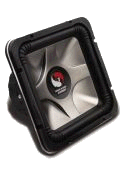 |
| Traditional Subwoofer Image courtesy of JL Audio |
Square Cone Subwoofer |
There are several manufacturers that offer non-typical subwoofer applications. Examples are the tube type subwoofer and the vehicle specific subwoofer system. Tube subwoofers are cylinders (tubes) with one end containing the subwoofer and the other end sealed (or ported in the case of Bazooka brand tubes. These are a fairly common way of adding a subwoofer to a limited space application or a leased vehicle and come in self-amplified varieties as well. Vehicle specific subwoofer systems are usually built from wood and fiberglass and are designed to fit snugly into a factory void or pocket. Because they are specific to one vehicle they are more expensive then either a standard box or tube configuration. However they can’t be beat for fit and use of space.
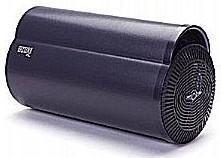 |
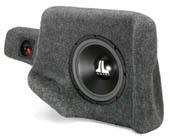 |
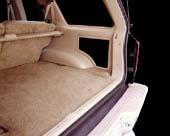 |
| Tube type subwoofer Image courtesy of Bazooka |
Vehicle Specific Enclosure Image courtesy of JL Audio |
Enclosure Installed Image courtesy of JL Audio |
One final note when purchasing a subwoofer. Determine how much space you are willing to give up and then decide what subwoofer you want. You don’t want to decide you want two 15” woofers and then realize they won’t fit in your Geo Metro after you're out of the store. Be realistic about your goals for the system and the space you are willing to sacrifice to achieve those goals. If you want strong bass but have limited space, add more power to your subwoofer system. This is all part of system planning.
Aspects and features that need to be considered when purchasing subwoofers are:
Enclosure Type: This is the type of box or enclosure your subwoofer will be mounted in. The main types are infinite baffle, sealed, vented (ported), and bandpass.
Excursion: The amount of travel the speaker has in its cone assembly. The larger the excursion the more air (and sound) it can put out. This is measured as Xmax.
Power Handling: This is the amount of power a speaker can withstand before failing after a given amount of time. The most important number is the speakers continuous or RMS power handling. Peak power handling means virtually nothing.
Resonant Frequency (Fs): The frequency at which a speaker naturally vibrates. The lower the number the lower the frequency the speaker should be able to reproduce. This value will become less important once the speaker is in an enclosure since the total system resonance will need to be taken into account.
Sensitivity: This is a reference measure of how loud a speaker will be with a certain amount of power at a certain distance. The standard is one watt at one meter. By halving the distance an increase of six decibels will be realized and doubling the power will increase the output by three decibels. This is a trick used by some companies to make their speakers appear more efficient than they are. Most loudspeakers will be in the ninety decibel range. Keep in mind that a difference of three decibels is equivalent to a doubling of the amplifier power.
Xmax: The distance a speaker can move forward and backwards, usually measured in millimeters (mm). More is better. Like power output of an amplifier, make sure you are comparing apples to apples. Some manufacturers specify one-way travel while others specify two-way travel (twice the one way travel distance). You should be comparing one-way, linear excursion.
![]()
Training DVDs
![]() Complete DVD Special
Complete DVD Special
Car Stereo Installation
Car Alarm Installation
Advanced Enclosures
Fiberglass Fabrication
Fiberglass Fabrication II
![]()
Car Audio Planning and Buying
Sample Systems
OEM Upgrades
Spotting Good Equipment
Where to Buy New
Tips for Buying New
Get the Best Retail Deal
Free Installation
Common Scams
Avoiding Bait and Switch
Mail Fraud Laws
Where to Buy Used
Tips for Buying Used
More Than You Can Afford
Buying Wholesale
Selling Used Audio
Hidden Costs
Car Audio Installation
Installation Goodies
Installations You Can Do
Car Stereo Help
Car Audio Care
Keeping Your Stereo Safe
Car Stereo Insurance
Making Your Stereo Last
Car Audio Warranties
Getting Free Repairs
Avoiding Noise Violations
Car Audio Safety
![]()
Equations
Contact
Terms of Use
Privacy Policy
